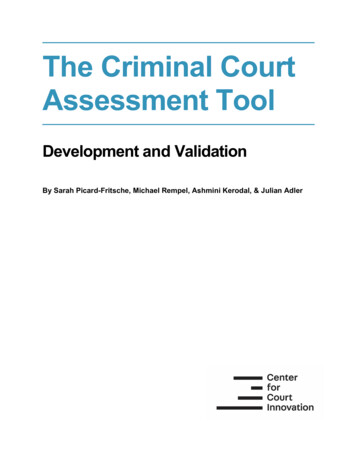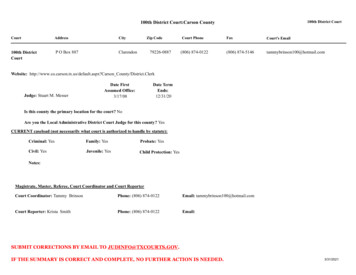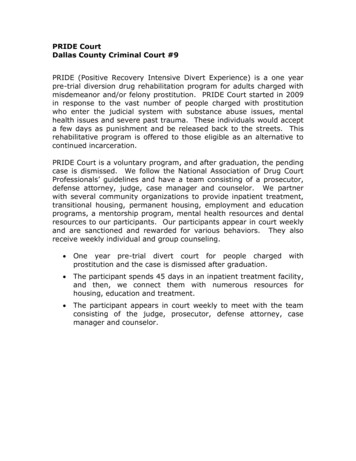
Transcription
The Criminal CourtAssessment ToolDevelopment and ValidationBy Sarah Picard-Fritsche, Michael Rempel, Ashmini Kerodal, & Julian Adler
The Criminal Court Assessment Tool: Development and ValidationBy Sarah Picard-Fritsche, Michael Rempel, Ashmini Kerodal, & Julian Adler January 2018Center for Court Innovation 520Eighth Avenue, 18th Floor NewYork, NY 10018p. 646.386.3100f. 212.397.0985www.courtinnovation.org
AcknowledgementsThis study was funded by the Bureau of Justice Assistance (award # 2012-DB-BX-K003).The opinions, findings, conclusions, and recommendations expressed in this report are thoseof the authors and do not necessarily reflect the positions or policies of the Bureau of JusticeAssistance.We are indebted to many external partners for the success of this project. Specifically, wethank Dr. Edward Latessa of the University of Cincinnati for his invaluable insight into thedevelopment and validation of the tool. We are also grateful to Jerry McElroy, Peter Kiers,Richard R. Peterson and Catherine Alexander at the New York City Criminal JusticeAgency, and Justin Barry, Chief Clerk of the New York City Criminal Court, without whomthe research would not have been practically possible. Finally, for conducting the fieldresearch in both the development and validation phases, we thank Suvi Hynynen Lambsonand Joseph Spadafore from the research department at the Center for Court Innovation, andthe following research assistants: Bettina Muenster, Sara DeConde, Cara Camacho, KimDalve, Glenda Folsom, Alison Lazaro, Julia Shuliko, Samantha Duter, Kirby Fowler, LauraPelcher, Ishara Ruffins, Julia Campregher and Tanya Santiago.We thank Greg Berman, Director of the Center for Court Innovation, for his comments on anearlier version of the report.Data related to criminal history and recidivism was provided by the New York State Divisionof Criminal Justice Services (DCJS). The opinions, findings, and conclusions expressed inthis publication are those of the authors and not those of DCJS. Neither New York State norDCJS assumes liability for its contents or use thereof.For correspondence, please contact: Sarah Picard-Fritsche at fritsches@courtinnovation.org.Acknowledgementsi
Table of ContentsAcknowledgementsExecutive SummaryiiiiChapter 1.Introduction1The Criminal Court Assessment Tool (C-CAT)Field TestingThe Present Study268Chapter 2.Methods9Data CollectionAnalysis910Chapter 3.Findings12Re-Arrest RatesValidationRisk ProfileNeeds Profile12141719Chapter s22AppendicesAppendix A. Overview of Comprehensive AssessmentAppendix B. C-CAT (Original)Appendix C. Split Sample ComparisonTable of Contents242535ii
Executive SummaryData-driven risk assessment tools play an increasingly important role in the criminal justicesystem, influencing decisions as diverse as pretrial release and the conditions of communitybased supervision. In addition to providing evidence-based classifications of defendant risk(e.g., low, moderate, or high risk), many tools include needs assessments, which identifyunderlying problems that may be addressed through therapeutic or social service interventions.Despite their advantages, many risk-need assessment tools require clinical expertise andsubstantial time with each defendant to effectively administer, making them unrealistic inmany criminal justice contexts. To date, there remains a shortage of risk-need assessmenttools that cover important needs fueling a defendant’s criminal behavior, yet can be efficientlyadministered in high-volume settings and inform referral to effective intervention. Withfunding from the Bureau of Justice Assistance, the Center for Court Innovation developed theCriminal Court Assessment Tool (C-CAT) in order to fill this gap. This report summarizesboth the development of the C-CAT and the results of a validation study with a sample ofdefendants drawn from the Brooklyn Criminal Court in New York City.Development and Structure of the C-CATInitial DevelopmentDrawing on Risk-Need-Responsivity theory and input from a panel of external experts, acomprehensive 183-item assessment tool covering 18 risk and need domains was developed.Beginning in February 2013, the comprehensive assessment was pilot-tested with 964defendants appearing in three misdemeanor diversion programs in New York City.Ultimately, the tool was reduced to those items statistically associated with recidivism orconsidered key “responsivity” factors (trauma and mental health). This 30-item risk-needassessment became the first iteration of the Criminal Court Assessment Tool (C-CAT).Field Testing and ValidationA second sample of 928 defendants awaiting arraignment in Brooklyn, New York were reassessed using the original C-CAT tool. This second sample, because it consisted of arepresentative array of felony, misdemeanor, and violation level defendants awaitingarraignment in the Brooklyn Criminal Court, was more generalizable to a general criminalcourt population. Results with the second, Brooklyn-based sample were analyzed with theprimary purpose of confirming the tool’s predictive accuracy and refining the tool based onnew data.Executive Summaryiii
Specifically, the Brooklyn-based sample was split into two halves, one used for testing andrevision of the original tool (“development sample”), and the other used for validation of anyrevised algorithms that might be produced (“validation sample”). Drawing on thedevelopment sample, bivariate and multivariate regression techniques were used to revisealgorithms for classifying risk in a general criminal court population. Stated simply, analysisdemonstrated that the original C-CAT tool could and should be improved to fit a more diversedefendant population, and the risk algorithm was revised accordingly. Using the validationsample, the revised algorithm was validated, using standard area-under-the-curve (AUC)techniques to assess predictive accuracy.Revisions to the original tool were also informed by the experience of users, who field-testedthe first iteration of the C-CAT in six sites across the country. User feedback has informedboth the content and structure of the final tool.The final C-CAT is intended to support evidence-based decision-making in high-volumecriminal justice contexts, such as criminal courts, community courts, and pretrial servicesagencies. To that end, the content of the tool reflects three primary goals:1. Accuracy: Design a tool that is a stable predictor of re-arrest in a general criminalcourt population and that reliably classifies defendants into risk categories withmeaningfully different re-arrest rates.2. Efficiency: Design a tool that can be administered and scored in 20 minutes or lesswithout requiring extensive training or clinical expertise.3. Responsivity: Design a tool to support practitioners in identifying treatable needs that areeither directly linked to recidivism or relevant for correctional intervention.In terms of structure, the final C-CAT is separated into four distinct sections: Administrative;Criminal Records Review; Defendant Interview; and Scoring Risk and Need. The number ofrisk points associated with each item in the tool, and the algorithms for calculating riskcategories and needs flags, are clearly displayed in the tool. The transparent structure of thetool and its algorithms are intended to facilitate effective administration and to support localresearch—including local validation studies—for those jurisdictions that are interested.Findings from the Validation StudyThis report is primarily concerned with research findings from the Brooklyn-based validationstudy and revisions to the final C-CAT that resulted from these findings. Researchparticipants in the Brooklyn sample had an average age of 32, and were largely male (83%)and black (68%) or Hispanic (24%). While the majority of the sample had at least one priorarrest (79%) and nearly half had a prior conviction (43%), few had a prior conviction for aExecutive Summaryiv
violent felony offense (13%). Concerning the current charge, 37% were arrested on a felony,and 63% were arrested on a misdemeanor. Re-Arrest Rates: Almost half of the Brooklyn sample (48%) were re-arrested over theone-year study tracking period, with 26% arrested on a felony, but only 9% arrested ona violent felony charge. Validation of the Original C-CAT Tool: There was a substantial loss of predictiveaccuracy when the original C-CAT algorithm was translated from the misdemeanordiversion program sample used in the first phase of research to the general criminal courtsample. Specifically, the AUC statistic for the raw risk score dropped from .795 to .705. Revised C-CAT Algorithm: Using only the “development sample” (i.e., a randomselection of half of the cases in the full sample, n 464), a revised risk algorithm wascreated to improve the performance of the tool for a general criminal court population.With the exception of a revision to the current charge item, all of the existing criminalhistory factors were retained in the revised tool, although weights were adjusted. Inaddition, several need factors were no longer important to risk classification and wereremoved from the revised tool. Revalidation: Using only the “validation sample” (i.e., the other randomly selected halfof the full sample, n 464), the revised algorithm was validated and shown to achievestrong predictive accuracy. Specifically, the revised raw risk score produced an AUCstatistic of .758. After consolidating the risk score into four categories—low risk,moderate risk, moderate-high risk, and high risk—the AUC was reduced to .748. Risk Distribution: Just under one-fifth of the full sample fell into the low riskcategory (18%), approximately two-thirds (66%) fell into the two moderate riskcategories (moderate and moderate-high), and 16% fell into the high risk category. Risk Category Precision: The risk categories created for the revised C-CAT performwell in terms of discrimination, as demonstrated by a substantial increase in average ratesof re-arrest at each category. For the full sample over the one-year tracking period, theaverage re-arrest rates were 17% for the low risk category, 38% for moderate risk, 61%for moderate-high risk, and 76% for high risk.Needs Profile Criminogenic Needs: Over half of the Brooklyn sample reported current drug use(52%), 48% percent were unemployed at the time of arrest, and 12% reported living onExecutive Summaryv
the streets or in short-term shelters. Responsivity Factors: In keeping with prior validation research, we found that selfreported symptoms of trauma and mental illness were not directly predictive of rearrest. Nonetheless, these factors have important implications for correctional treatmentand were prevalent in the current sample. Specifically, 46% of the sample flagged on atwo-item PTSD screener and 39% reported current symptoms or a history of mentalillness. Needs Flags: Needs flags appearing in the C-CAT are intended to alert practitionersusing the tool of potential need areas and are not diagnostic. Based on feedback frompractitioners piloting the original C-CAT in the field, flags for criminal thinking andyouth services were removed from the revised tool while the flag for mental illness wasrevised to be more specific (flag fewer individuals as potentially needing mental healthservices).Conclusion and ImplicationsOur findings largely support the use of Risk-Need-Responsivity as a theoretical frameworkfor the development of risk-need assessment tools. Ultimately, the goal of the project was tocreate an accurate and efficient risk and needs assessment tool for high-volume environmentssuch as general criminal courts, community courts, or pretrial services agencies. The finalstructure and content of the tool are influenced both by our quantitative findings and feedbackfrom practitioners field-testing the original C-CAT in Chicago, Los Angeles, Washingtonstate, Oregon, and New York City.A key finding from the project is the extent to which the best model for classifying riskchanged noticeably with the shift from a purely misdemeanor sample participating indiversion programs to a general criminal court sample that was more diverse in terms ofcurrent charge severity and criminal history. This finding adds to a growing consensus in thefield in favor of the use of locally validated risk assessment tools. In short, jurisdictionsconsidering adoption of the C-CAT—or similarly developed tools—should be cognizant ofthe need to re-validate the tool and potentially adjust item weights and risk categories tobetter fit the specific court or program population.Executive Summaryvi
Chapter 1IntroductionActuarial risk assessment tools play an increasingly important role in the criminal justicesystem, influencing decisions as diverse as pretrial release and the conditions of communitybased supervision. In contrast to traditional risk assessment, which relies largely on theprofessional discretion of judges, correctional officers, or other practitioners, actuarial toolsdraw on large datasets and use statistical prediction methods to classify individuals accordingto their probability for a new arrest. A growing body of research suggests that high-quality riskassessment tools outperform professional judgment alone in predicting recidivism (Gendreau,Little, and Goggin 1996; Hanson and Morton-Bourgon 2009; Picard-Fritsche et al. 2016; Moriet al. 2017).A 2013 overview of 19 risk assessment tools reveals significant diversity in form, content andpredictive accuracy (Desmarais and Singh 2013). The simplest tools rely exclusively oncriminal records, while others add a short defendant interview and produce a single risk scoreor classification (e.g., low, moderate, or high risk). Still other tools constitute morecomprehensive risk and need assessments that require a long interview. Beyond riskclassification, these longer tools offer the benefit of identifying treatable needs that are oftenlinked to criminal behavior (“criminogenic needs”) and supporting the targeted use oftherapeutic or social service interventions for reducing recidivism.Many risk-need assessment tools also offer the advantage of being grounded in Risk-NeedResponsivity theory, a rehabilitative model of crime prevention supported by more than threedecades of research (e.g., see Andrews and Bonta 2010; Andrews et al. 1990; Latessa, Cullen,and Gendreau 2002; Gutierrez 2009; Looman and Abracen 2013). At its core, this theoryholds that correctional and clinical resources should focus on higher-risk groups and thatintervention should focus on those needs most associated with risk for recidivism, laying outeight “central” factors that increase risk:1.2.3.4.5.Criminal HistoryAntisocial Temperament/ImpulsivityCriminal Thinking/Antisocial BeliefsCriminal Peer NetworksEducation/Employment DeficitsChapter 1. IntroductionPage 1
6. Family/Relationship Problems7. Substance Abuse8. Lack of Prosocial Leisure ActivitiesFinally, the developers of Risk-Need-Responsivity theory emphasize the importance oflinking individuals to correctional treatment that is responsive to their individual needprofiles, including factors not directly predictive of recidivism, such as trauma and mentalillness. Some risk-need assessment tools, such as the original Level of Services Inventory(LSI), include assessments of mental health or other responsivity factors (Andrews and Bonta1995; Taxman 2014).Despite their advantages, comprehensive risk-need assessment tools may require clinicalexpertise and substantial time with each defendant to effectively administer, making themunrealistic in many criminal justice contexts, such as high volume courts or communitysupervision agencies. While short, static risk tools—i.e., tools that do not require a defendantinterview and are largely based on criminal history factors—have been developed for pretrialsettings, these are also insufficient to the larger goals of many decision-makers who areinterested in reducing risk through diversion or targeted interventions that address underlyingneeds. To date, there remains a shortage of risk-need assessment tools that cover importantneeds, yet can be realistically administered in high-volume settings and inform referral toeffective intervention.The Criminal Court Assessment Tool (C-CAT) is designed to fill this gap and to be validatedfor general criminal court populations—i.e., populations that are diverse in terms ofdemographics, charge type, and charge severity. This report provides an overview of thedevelopment of the C-CAT and its validity for classifying recidivism risk.The Criminal Court Assessment Tool (C-CAT)DevelopmentOriginally developed on a sample of misdemeanor defendants appearing in threemisdemeanor diversion programs in New York City,1 the C-CAT is a 25-item risk-need1The initial sample was drawn from three sites: Bronx Community Solutions, the MidtownCommunity Court in Manhattan, and the Red Hook Community Justice Center in southwestBrooklyn. These programs serve a diverse population of tens of thousands of misdemeanordefendants annually. Because interviews were primarily conducted post-arraignment withindividuals mandated to community service or social service, individuals whose cases ended withother disposition types at arraignment (e.g., jail or straight dismissal) are under-represented.Chapter 1. IntroductionPage 2
assessment tool grounded in Risk-Need-Responsivity theory. Tool development was guidedby three specific goals:1. Accuracy: Design a tool that is a stable predictor of re-arrest in a general criminalcourt population and reliably classifies defendants into risk categories withmeaningfully different re-arrest rates.2. Efficiency: Design a tool that can be administered and scored in 20 minutes or lesswithout requiring extensive training or clinical expertise.3. Responsivity: Design a tool to support practitioners in identifying treatable needs thatare either directly linked to recidivism or relevant for successful correctional intervention.In order to ensure that the final C-CAT would provide robust information about both riskand need, a comprehensive assessment instrument was created, which included 183 itemswithin 16 domains considered relevant to understanding criminal risk or developingeffective interventions for justice-involved individuals.2 Appendix A provides an overviewof the domains included in the comprehensive assessment and model tools considered inits development. Using the comprehensive assessment, data were collected from 964misdemeanor defendants in New York City over a one-year period from February 2013 toFebruary 2014.After the data were collected, the research team used descriptive statistics and multivariateregression techniques to reduce the comprehensive assessment to only those factors that werefound to be either: (a) predictive of re-arrest; or (b) prevalent in the defendant population andimportant to responsive correctional intervention (e.g., trauma, mental health). The resultingshortened tool became the “original” C-CAT, a copy of which is included in Appendix B ofthis report. As the seen in the original tool, our analysis produced five recidivism riskcategories, ranging from minimal to high. Figure 1.1 displays the re-arrest rates for each riskcategory in the original sample, illustrating the tool’s ability to distinguish risk categories withmeaningfully different re-arrest rates.2For further details on the Phase One research, please see: Rempel, Michael, Suvi HynynenLambson, Sarah Picard-Fritsche, Julian Adler, and Warren Reich. 2017. Understanding Risk andNeed in Misdemeanor Populations: A Case Study form New York City. New York: Center for CourtInnovation.Chapter 1. IntroductionPage 3
To assess the validity of the original C-CAT for predicting re-arrest, researchers conductedan area-under-the curve (AUC) analysis, a standard procedure for determining the accuracyof risk scales within and outside the field of criminal justice. AUC statistics range from .5 to1, with higher statistics reflecting lower rates of error (e.g., classifying someone who is highrisk as low risk or vice versa). By current industry standards, an AUC statistic of .70 orhigher is considered “good”, while an AUC in the .60 to .70 range is considered“acceptable.” As Table 1.1 shows, the original C-CAT demonstrated strong predictiveaccuracy. However, it should be noted that AUC statistics are often higher on developmentsamples. In other words, it is normal for the predictive accuracy of a tool to diminishsomewhat when re- tested on new samples, since the tool is expressly designed to maximizeperformance on the original sample. Additionally, because the original sample used todevelop the C-CAT was not truly representative of New York City, but was instead drawnfrom three programs that tend to serve higher risk and need misdemeanor offenders, it wasassumed some revisions might be necessary to achieve good predictive accuracy in a moregeneral population.Chapter 1. IntroductionPage 4
Table 1.1 Area Under the Curve StatisticsTotal Sample Size1Raw Risk Score2Risk Categories6660.7950.7831298 cases were dropped due to administrative matching issues.2Range of possible risk scores: 0-593Minimal, Low, Moderate, Moderate-high, HighStructure of the C-CATThe C-CAT assessment tools (both the original and the final, validated tool) were designedfor ease of administration and transparency in terms of how the raw risk score, riskcategories, and needs flags are calculated. Specifically, the tool is separated into four distinctsections:31. Administrative Information: Allows for the collection of administrative datacommonly collected by courts or supervision agencies (e.g., case number, arrest date,arrest charge), which can facilitate case-level research, including local validation studies.2. Criminal Record Review: Allows the user to create a subtotal risk score based onstatic factors that do not require a defendant interview (i.e., criminal history factors). Thenumber of risk points associated with each criminal history factor is clearly displayed inparentheses next to the item and instruction for scoring are at the top of the section.3. Defendant Interview: Includes a short interview, with detailed instructions for theadministrator. The interview items primarily correspond to the dynamic variables (e.g.,education, substance use) that are also predictors of recidivism (“criminogenic needs”).Like the previous section, the risk points associated with each factor are clearly displayedand the section allows a subtotal risk score to be calculated. A separate, clearly delineatedportion of the defendant interview asks about need factors not directly related to re-arrest(i.e., mental illness and trauma).4. Scoring Risk and Needs: This final section clearly lays out the steps for calculatingthe raw risk score and placing the defendant into the appropriate risk category.Additionally, instructions are provided for calculating indicators of need in importantareas (e.g., substance abuse, employment, mental health, trauma). Each of these “needflags” draws on one or more items in the risk assessment tool and should not be3The original C-CAT (30 items) is included with this report as Appendix B. The final, validatedC-CAT (25 items) is published separately.Chapter 1. IntroductionPage 5
considered diagnostic, but instead an indicator of potential need in that area.Field TestingCreating a practical and informative tool for a variety of high-volume contexts was anotherimportant goal for the project. To assess the utility of the tool from the practitionerperspective, the original C-CAT has been field-tested in multiple settings since itsdevelopment was complete in late 2014:Cook County Misdemeanor Enhanced Diversion ProjectFrom February 2015 to September 2016, the Cook County State Attorney’s office used theC-CAT to inform length and type of mandate for first-time misdemeanants diverted fromprosecution to community-based services in two geographically-defined courts within CookCounty.Specifically, defendants who were assessed as moderate- or high-risk are tracked tocommunity service or short term cognitive behavioral interventions, respectively, while lowrisk participants receive a one-day referral for further assessment. The validity of the C-CATfor assessing recidivism risk in a sample of 260 misdemeanor defendants in Cook County iscurrently being conducted as a component of a larger impact evaluation of the program.Los Angeles Neighborhood Justice PanelsIn September 2015, the Los Angeles (LA) City Attorney’s office expanded its neighborhoodrestorative justice program to two new neighborhoods (West Hollywood and South LosAngeles) and integrated the C-CAT into the program. Case managers administer the C-CATat intake and use needs flags to refer defendants to appropriate services. Additionally, projectmanagers plan to use a risk profile of their participants, generated by the C-CAT, as a basisfor expanding eligibility criteria beyond first-time offenders.Spokane, Olympia, and Eugene Community CourtsThree community courts have adopted the C-CAT over the last year—Eugene, Oregon(August, 2016), Spokane, Washington (December 2016), and Olympia, Washington (January2017). In all three sites, the courts are using results of the tool to track higher risk defendantsinto more intensive case management and to inform types of social service or clinicalmandates. The Spokane Community Court has partnered with Washington State University toconduct a local validation of the C-CAT.Chapter 1. IntroductionPage 6
Center for Court Innovation Demonstration Sites (New York City)Beginning in March 2016, the C-CAT has been in use in several of the Center’s NYC-basedalternative-to-incarceration (ATI) and supervised release programs, including BrooklynJustice Initiatives (ATI and supervised release) and supervised release programs in the Bronxand Staten Island. The results of the C-CAT are being used to inform the level of follow upand types of referrals for supervised release programs, and the types of service mandates forATI.User feedback highlighted the importance of customization of the tool on a site-by-site basis.For example, in Cook County, risk categories were revised to accommodate the loweraverage risk score of defendants referred to pretrial diversion. In Spokane, Olympia, andEugene, the substance use section of the tool was revised to accommodate changes in statemarijuana laws. In New York City, revisions were made to the criminal history section of thetool to increase the efficiency of administration.With respect to the interview content, users across multiple sites reported specificchallenges to collecting reliable data on some of the needs items, in particular: Items regarding defendant attitudes in the original C-CAT are difficult to administer inhigh-volume settings (more appropriate for a longer assessment); Items regarding intimate partner relationships and relationship stress are perceived asintrusive and are not relevant to effective intervention or case management; Items that ask about the symptomology of mental health problems are difficult for nonclinically trained staff and may not be reliable; Items that add risk points based on the number of residential moves may be unfair toyounger participants, a population for whom frequent moves are normal; The current structure of the mental health “needs flag” is too broad (flagging to manypeople) and should be more conservative; From a practical perspective, users from several sites reported that the C-CAT was stilltoo long to be an efficient tool prior to arraignment and can only be used after a case isresolved, limiting its utility for supervision dosage decisions.Chapter 1. IntroductionPage 7
The Present StudyThe remainder of this report is focused on the validation phase of the research, whichinvolved reexamining the original short assessment tool in a general criminal courtpopulation; revising the tool based on these findings; and validating the revised tool on aseparate sample of cases. Specifically, we present analysis addressing the following threeresearch questions:1. Validation: Is the C-CAT an accurate predictor of re-arrest in a general criminal courtpopulation in New York City?a. Does a revised C-CAT algorithm, developed using a general criminal courtsample in New York City, accurately predict recidivism?2. Risk Profile: What is the distribution of risk for re-arrest, as calculated by the revised CCAT, among a general criminal court population in New York City? Do the C-CAT riskcategories represent meaningful differences in re-arrest probabilities?3. Needs Profile: Which of the C-CAT needs flags are most prevalent in a generalcriminal court population in New York City?The report is organized as follows: Chapter 2 describes the methodology utilized forvalidation of the C-CAT; Chapter 3 presents findings for each research question; and Chapter4 concludes the report by discussing the implications of the findings for policy and practice.Chapter 1. IntroductionPage 8
Chapter 2MethodsThe present research took place in a pre-arraignment holding facility in the centralizedBrooklyn Criminal Court in Brooklyn, New York, and represents a collaboration betweenresearchers with the Center for Court Innovation and staff with the New York City CriminalJustice Agency (CJA). For over 40 years, CJA has conducted pretrial assessments of individualsdetained prior to arraignment—generally for about 24 hours until the arraignment takes place—in order to inform subsequent release decisions. During the current study, CJA staff introducedthe study to potential participants as part of the course of their usual assessment process, androuted study volunteers to Center for Court Innovation staff to be interviewed. Studyparticipants included approximately 1,100 defendants who were arrested and detained prior
criminal justice contexts, such as criminal courts, community courts, and pretrial services agencies. To that end, the content of the tool reflects three primary goals: 1. Accuracy: Design a tool that is a stable predictor of re-arrest in a general criminal court population and that reliably classifies defendants into risk categories with










